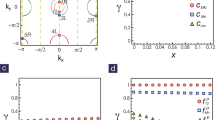Abstract
We investigate the effect of k-space broadening of the interlayer pairing kernel on the critical temperature Tc and the k-dependence of the gap function in a one-dimensional version of the interlayer pair-tunneling model of high-Tc superconductivity. We consider constant as well as k-dependent intralayer pairing kernels. We find that the sensitivity to k-space broadening is larger the smaller the width of the peak of the Fermi-level gap calculated for zero broadening. This width increases with the overall magnitude of the interlayer tunneling matrix element, and decreases with the bandwidth of the single-electron intralayer excitation spectrum. The width also increases as the Fermi level is moved towards regions where the excitation spectrum flattens out. We argue that our qualitative conclusions are valid also for a two-dimensional model. This indicates that at or close to half-filling in two dimensions, when the Fermi-surface gap for zero broadening attains its peaks at (±π/a, 0) and (0, ±π/a) where the excitation spectrum is flat, these peaks should be fairly robust to moderate momentum broadening.
Similar content being viewed by others
REFERENCES
P. W. Anderson, The theory of superconductivity in the high-T c cuprates, Princeton Series in Physics (1997).
J. M. Wheatley, T. C. Hsu, and P. W. Anderson, Phys. Rev. B 37, 5897 (1988).
S. Chakravarty, A. Sudbø, P. W. Anderson, and S. Strong, Science 261, 337 (1993).
P. W. Anderson, Science 279, 1196 (1998). See also P. W. Anderson, Science 268, 1154 (1995); A. J. Leggett, 274, 587 (1996).
S. Chakravarty, Eur. Phys. J. B5, 337 (1998).
S. Uchida, K. Tamasaku, and S. Tajima, Phys. Rev. B 53, 14558 (1996). It may be argued from Fig. 4 of this reference that there is no sign of any Drude-peak in the c-axis normal state optical conductivity down to frequencies ω < 0.004 eV, in not overdoped compounds. A complete lack of a low-frequency Drude peak would indeed constitute nonmetallic behavior, since it would imply a vanishing plasma frequency, see W. Kohn, Phys. Rev. 133, A171 (1964). However, in all curves in Fig. 4 of Ref. 6, the c-axis dc-conductivity is non-zero in the doping range x ∈ [0.15, 0.20]. Although it may be argued, as done in Ref. 6, that these limiting values are so low that a metallic description is meaningless, this statement relies on a model dependent calculation, see M. Liu and D. Y. Xing, Phys. Rev. B 49, 682 (1994). Moreover, the loffe-Regel rule merely constitutes a crossover-criterion for separating metals from insulators. The minimal metallic conductivity is calculated within a specific model to be 50 Ω−1 cm−1, while the measured values are in the range 10–30 Ω−1 cm−1 in not overdoped compounds. Therefore, it is by no means excluded that the low-frequency results of Ref. 6 support the notion of a metallic c-axis normal state conductivity with a small plasma frequency. This would correspond to a low carrier density, precisely the situation for the not overdoped cuprates. Moreover, sharply peaked low-frequency features in the real part of the optical conductivity are not expected with ill-defined quasiparticles, i.e., a large scattering rate, at the Fermi level.
J. R. Kirtley, K. A. Moler, G. Villard, and A. Maignan, Phys. Rev. Lett. 81, 2140 (1998).
J. Schützmann et al., Phys. Rev. B 55, 11118 (1997).
K. A. Moler, J. R. Kirtley, D. G. Hinks, T. W. Li, and M. Xu, Science 279, 1193 (1998).
A. A. Tsvetkov et al., Nature 395, 360 (1998).
S. Chakravarty, H.-Y. Kee, and E. Abrahams, Phys. Rev. Lett. 82, 2366 (1999).
J. O. Fjærestad and A. Sudbø, in Symmetry and pairing in superconductors, Kluwer (1999).
J. O. Fjærestad and A. Sudbø, Physica B: Condensed Matter 261, 485 (1999).
A. Sudbø, J. Low. Temp. Phys. 97, 403 (1994).
It was shown in A. Sudbø, P. W. Anderson and S. Strong, Science 261, 337 (1993) Ref. 3 that (6) gives a critical temperature k B T c = T J /4 when the intralayer contribution to the pairing kernel is ignored. Including the contribution from the intralayer term gives, to lowest order, k B T c = (T J/4)[1 + 3(π/2)2 λ2], i.e., a quadratic λ dependence. In Ref. 3 a linear dependence was obtained, due to a specific approximation used for the pair susceptibility which is excellent for T J = 0, but inaccurate for T J ≠ 0.
P. C. Hohenberg, Phys. Rev. 158, 383 (1967); N. D. Mermin and H. Wagner, Phys. Rev. Lett. 17, 1133 (1967).
A. Sudbø and S. P. Strong, Phys. Rev. B 51, 1338 (1995).
D. Thelen, D. Pines, and J. P. Lu, Phys. Rev. B 47, 9151 (1993).
G. G. N. Angilella, R. Pucci, F. Siringo, and A. Sudbø, Phys. Rev. B 59, 1339 (1999).
Y. Lin, S. Chakravarty, and P. W. Anderson, Phys. Rev. Lett. 78, 3559 (1997).
Author information
Authors and Affiliations
Rights and permissions
About this article
Cite this article
Fj\sgmaelig;restad, J.O., Sudbø, A. Non-k-Diagonality in the Interlayer Pair-Tunneling Model of High-Temperature Superconductivity. Journal of Low Temperature Physics 116, 231–243 (1999). https://doi.org/10.1023/A:1021889718016
Issue Date:
DOI: https://doi.org/10.1023/A:1021889718016




